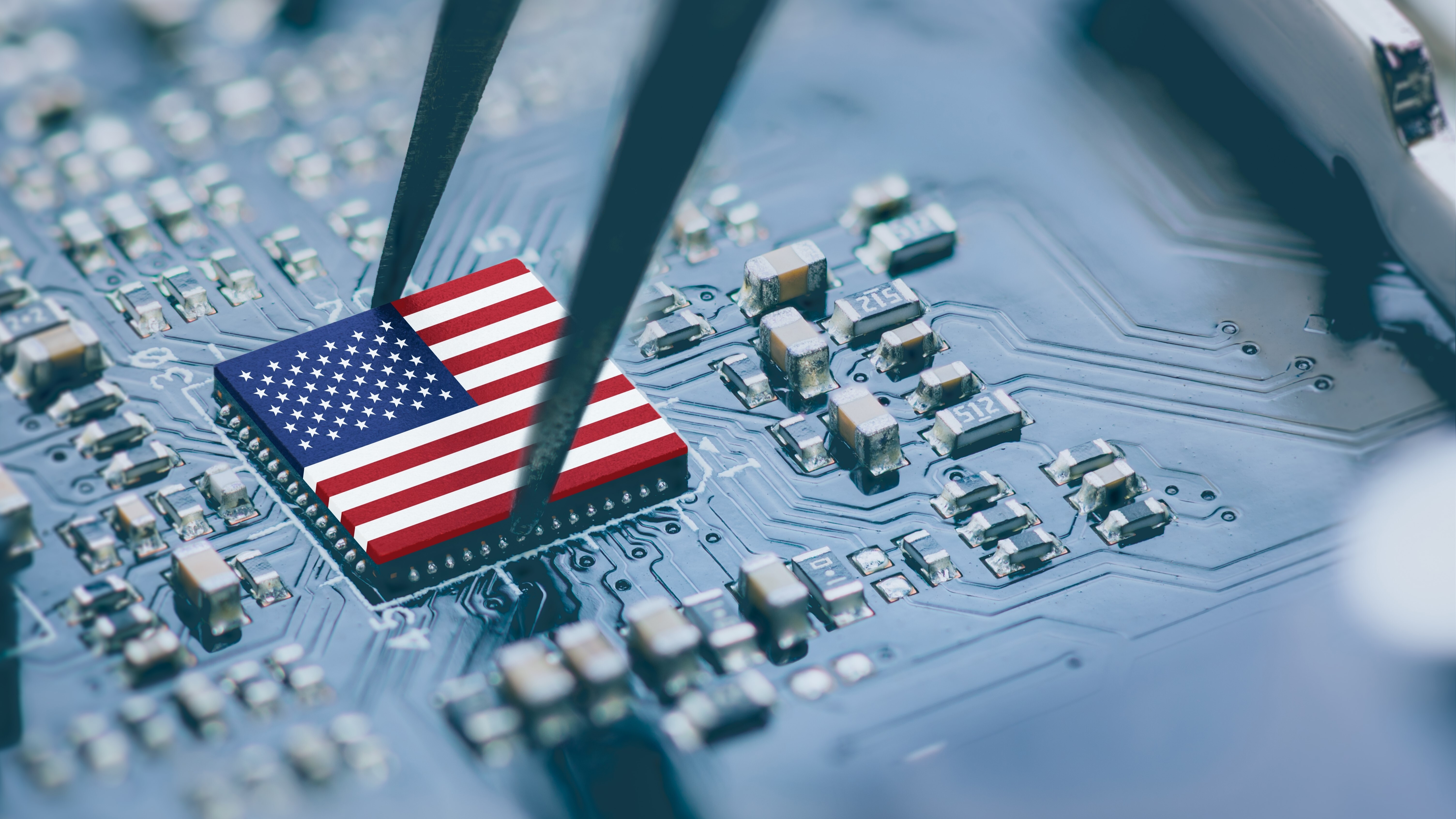The US is spending more money on chip manufacturing construction this year than the previous 28 years combined
The CHIPS Act is crushing expectations

The Biden administration's CHIPS Act is pumping money into chip manufacturing construction at an historic rate. According to a recent report from the U.S. Census Bureau, the growth of computer and electrical manufacturing construction funding is so great that the U.S. government will add as much funding to the sector in 2024 alone as it did in the prior 27 years.
A recent tweet by Martin Chorzempa, Senior Fellow at the Peterson Institute, called attention to the surge and illustrated the meteoric spending growth of the last few years. (Be sure to expand the embedded tweet to see the full graph.) Note that the numbers shown represent realized spending numbers on construction — not just budgeted prices.
Chips Act is attracting insane amount of investment. US is now on pace to add more investment in electronics manufacturing construction this year alone as it did TOTAL from 1996 until passage of the chips act in 2020 (funding not yet secured then, but investment started) pic.twitter.com/rfBg4XKybpMay 31, 2024
The construction growth began in 2021, but its explosive boom is due to a massive boost in funding from the CHIPS and Science Act, the Biden administration's $280 billion spending package passed in 2022. The act was signed to help bolster the U.S. semiconductor industry, which accounted for effectively 0% of all advanced-process chips manufactured worldwide. Companies including Intel, Samsung, and Micron have all received billions of dollars to build new manufacturing plants in the United States. Domestic research and development is also a major focus of the funding package.
The construction funding is making a major impact on the United States' projected chip production. A recent Semiconductor Industry Association study found that the United States is due to triple its domestic chip manufacturing capacity by 2032, and is expected to be producing 30% of the world's leading-edge chips by the same year. This expectation exceeds even the government's inflated goals; U.S. Commerce Secretary Gina Raimondo boldly proclaimed a goal of 20% of the world's leading-edge chips just in February, which is now expected to be far exceeded.
Construction on most of the new plants is ongoing, like Intel's new Ohio campus which is taking over roads with its 900,000-pound loads. Intel's Ohio plant and many of its counterparts will be major players on the chip fabrication scene, with leading-edge chip process development expected to finally come to the United States, a step up from the larger and simpler processes typically relegated to U.S. fabs.
For all its expense, most of the fab construction across the country is experiencing major delays: Samsung, TSMC, and Intel are all a year or more behind schedule. This has been primarily blamed on poor regulations and makes the U.S. one of the slowest countries at chip fabrication construction in the world.
Get Tom's Hardware's best news and in-depth reviews, straight to your inbox.

Sunny Grimm is a contributing writer for Tom's Hardware. He has been building and breaking computers since 2017, serving as the resident youngster at Tom's. From APUs to RGB, Sunny has a handle on all the latest tech news.
-
thestryker Reply
Intel was leading in manufacturing process until N7 came online, Global Foundries was a competitor until they decided the capital requirements for "7nm" was too high, and politicians are notoriously slow acting about everything let alone something that they don't see as a problem. This is really something they should have been addressing in the 1990s as more manufacturing started to be offshored.dimar said:Why is it being done now and not 20 years ago?? Somebody needs to answer for that. -
Eximo Pretty much. US based manufacturing was the standard in the early PC days (or domestic production in general for the target consumers of any country). All those companies started off shoring to reduce labor costs. Corporations did this during the 80s and 90s because they could and it was extremely profitable. Lobbying and the like made sure that nothing would hurt business growth at the time. Why the 80s were synonymous with the greedy business man in media. Corporate takeovers to then offshore the production while keeping the brand was a really common practice.Reply
Not limited to the semiconductor industry either. At the same time vacuum tubes, televisions, tape players, and pretty much all facets of consumer electronic technology moved offshore. -
gamerk316 Reply
Ronald Reagan.dimar said:Why is it being done now and not 20 years ago?? Somebody needs to answer for that.
His economic policy shaped US economic policy for 50 years, and was based around keeping inflation low at all costs. This was done through a combination of means: Low taxes, suppression of wages, and embracing supply-side principles to lower unit costs. This in turn led to manufacturing desperately trying to lower their production costs, leading directly to the collapse of American manufacturing.
Basically, everyone is finally admitting the economic policy of the 80s has been a disaster. -
bolweval Reply
So lower taxes and lower wages led to manufacturing trying to lower production costs which led to the collapse of American manufacturing, huh?????🤔gamerk316 said:Ronald Reagan.
His economic policy shaped US economic policy for 50 years, and was based around keeping inflation low at all costs. This was done through a combination of means: Low taxes, suppression of wages, and embracing supply-side principles to lower unit costs. This in turn led to manufacturing desperately trying to lower their production costs, leading directly to the collapse of American manufacturing.
Basically, everyone is finally admitting the economic policy of the 80s has been a disaster.
Cheap Chinese labor and greedy corps led to then collapse, and unions driving UP labor costs, pricing themselves out of the market…
You can sure tell this is an election year! LoLz -
JamesJones44 Reply
It goes well beyond Reagan. The US would have had a lot more investment if Clinton and George JR didn't sell out US tech for cheap manufacturing in China and elsewhere.gamerk316 said:Ronald Reagan.
His economic policy shaped US economic policy for 50 years, and was based around keeping inflation low at all costs. This was done through a combination of means: Low taxes, suppression of wages, and embracing supply-side principles to lower unit costs. This in turn led to manufacturing desperately trying to lower their production costs, leading directly to the collapse of American manufacturing.
Basically, everyone is finally admitting the economic policy of the 80s has been a disaster. -
gamerk316 Reply
Remember that NAFTA was a brainchild of Bush Sr; the GOP tried to ram it through Congress after loosing in '92. Clinton added *significantly* more protections for American business then the original proposal.JamesJones44 said:It goes well beyond Reagan. The US would have had a lot more investment if Clinton and George JR didn't sell out US tech for cheap manufacturing in China and elsewhere.
But point remains: Lowering cost of production was the primary focus of US economic policy going back to Reagan, which ended up backfiring in the long term as the US priced itself out of most markets, except for cases where the government eats at least some of the cost. Hence the slow collapse of manufacturing over the past 50 years. -
JamesJones44 Reply
Fair, but each POTUS after Reagan for the next 20 years pretty much said "hold my beer". The worst being that China and other unfriendly countries were added to the WTO and given favored trade status.gamerk316 said:Remember that NAFTA was a brainchild of Bush Sr; the GOP tried to ram it through Congress after loosing in '92. Clinton added *significantly* more protections for American business then the original proposal.
But point remains: Lowering cost of production was the primary focus of US economic policy going back to Reagan, which ended up backfiring in the long term as the US priced itself out of most markets, except for cases where the government eats at least some of the cost. Hence the slow collapse of manufacturing over the past 50 years.